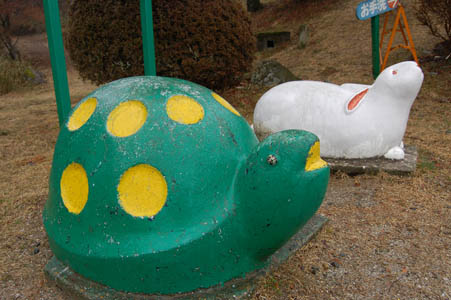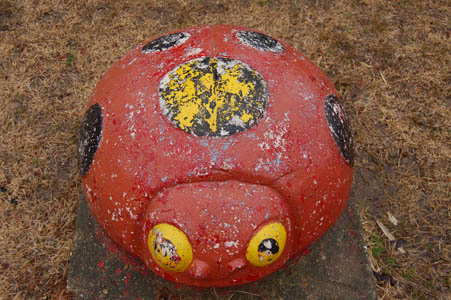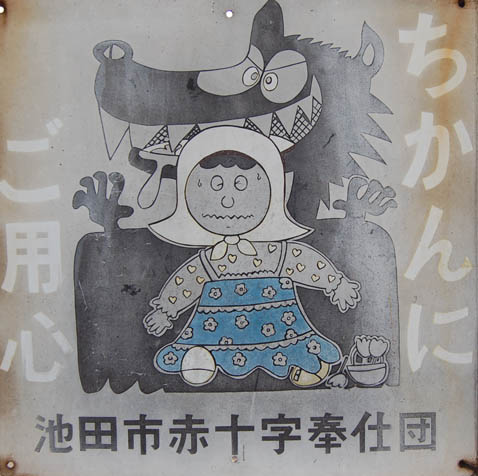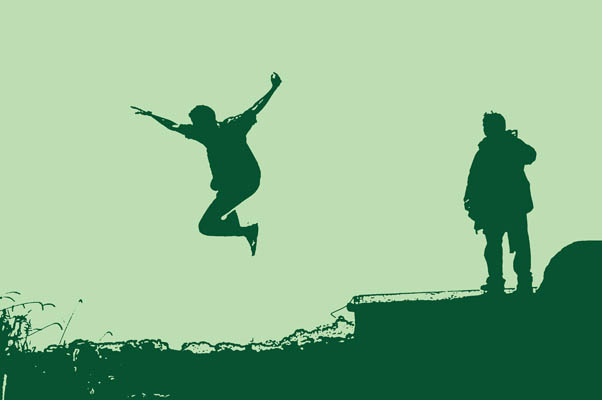
(Original picture courtesy of Justin)
This is dedicated to a fun, 3 hour hike in the rain with Justin and Taro, followed by a night of kushikatsu, drinking, karaoke, and onsening in Nara.
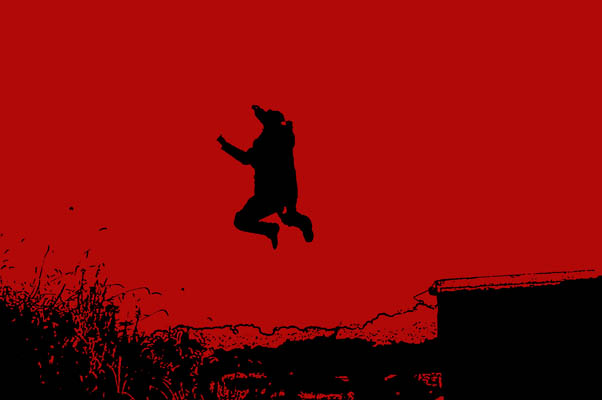
Red Jump Green Jump
Tanuki Ponpoko
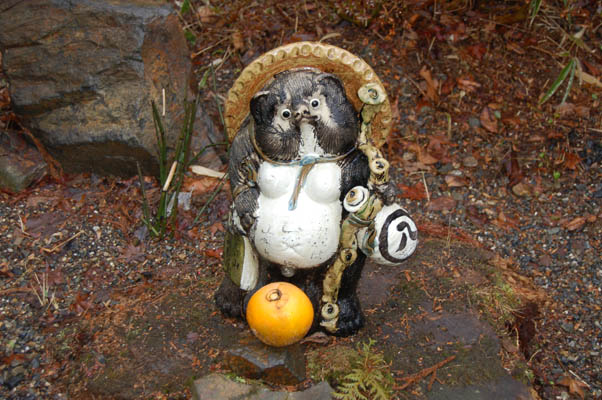
Ponpoko pon no pon is the onomotopoetic Japanese expression of how tanuki move. When I saw one running, I was impressed by the accuracy of which ponpoko pon no pon captures their wobbly gait.
Known erroneously as a “badger” or “raccoon” and more accurately as a “raccoon-dog”, Tanuki is the only word that fits this animal. The same goes for words like sushi, ramen (translated as Chinese noodle soup), tsukemono (Japanese pickles), miso (fermented soy bean paste), or samurai. The English translation takes something away from the native word by giving an unsatisfactory description.
Apparently, some people eat tanuki in the more rural areas. One of my brother?s friends from Tenri Daigaku described the meat as being gamy and tough. She said that a friend of her family came by the house and dropped off a parcel of meat, which they prepared in a miso-based broth. Miso, it was explained, is a good complementary base to use with gamy meat.
One of my friend?s grandfathers, who lives in Kita-Kyushu, is an avid huntsman. He regularly shoots tanuki but only keeps the fur. His daugher, my friend?s mother, makes the pelts into hats and other rustic clothing, which I like to think he wears on his hunting trips.
Recently I watched an excellent animation produced by Miyazaki Hayao called 平成狸合戦ぽんぽこ(Heisei Tanuki Gassen Ponpoko). At first glance I didn?t expect this anime to be anything that I would be interested in, but it actually deals with such serious issues as social, economic, and environmental problems, the chief one being urban sprawl in the Kanto region of Japan. I highly recommend this film to anyone who is interested in Japanese culture, folklore, or history, as it is bursting full of references to almost everything you can think of.
One thing that still alludes me about the tanuki is why udon with age on top is called tanuki udon, while putting this on top of soba makes it kitsune udon. Does anyone know anything about the history or lore dealing about these two popular meals?
Pets in Japan
It sucks to see pets being crammed together like this, warmed like chicken karaage under intense heat lamps.
Unfortunately, pet stores like this seem to be pretty successful. There are some humane society-like organizations, but they are not nearly as big or powerful as they are back in the states. Only in places like Ashiya have I ever seen pets up for adoption.
Walking down one of the many shotengai in Shinsaibashi, my brother points to a well-known pet store flanked by a pachinko parlor and a mom and pop store that?s been closed up for the night. ?That place got raided by the cops a few years ago. Thy got busted for keeping a tiger and other endangered animals in the back room.? he says. Yakuza like to keep such animals in their apartments to show off, supposedly.
The first thing you?re probably thinking when you look at these pictures is likely to be something like ?Look at the poor little furry animals! That?s so cruel!?
And I would agree with you. Puppies being abandoned in the wilderness or tortured for amusement, newborn kittens tossed into drainage systems during a rainstorm, toads being ripped apart by over-excited little boys, frogs getting blown up with firecrackers (some of these don’t count as pets, but illustrate the sadistic pleasure that some people get from torturing or destroying animals in general). Pets are neglected and waste away. It?s normal to see these things over here, but that’s only the most visible aspect of this subject.
But I would argue that most Japanese pets are treated like part of the family and are very well taken care of. It should be noted that many people that I know who take care of their pets properly either get them as part of a litter of a friend’s pet, or rescue them from a dire situation.
For those owners that keep their pets in tiny enclosed areas, I would argue that many would not consider this cruel. Many people in the city live their lives under similar (but admittedly different) circumstances. If you lived your whole life in a tiny apartment and spent every working day in a cramped office, you might not see anything wrong with keeping your pet in a similar environment. Master and pet, sharing the gaman.
Surprisingly, I think that the dogs of the homeless people live the best lives of all pets in Japan on average. They look the happiest, and seem to be well taken care of. Most homeless rely on their dogs to guard their possessions and property. They are valued companions. They also enjoy a greater degree of freedom than pets owned by people with houses, as they often get to play and hang out with other whenever they like.
If you walk along the Yodogawa, you will see improvised tombstones, bearing names like Kuro and Chibi. These weren?t just dogs, they truly were part of the family.
A Day at the Office
I’m not writing about anything especially interesting or though provoking. This is simply about an average day in the office over here.
It?s one degree outside. That?s what the screen on the wall-mounted air conditioner reads, but it doesn?t feel that bad once I get in the shower. Letting it run for 5 minutes makes the steam gush out when the door is opened, and it blankets everything in my compact bathroom with a thick coat of mist.
Though I?ve been awake for 50 minutes and acclimated to the light in my apartment, the glare of this clear day pierces my optic nerve like needles when I step out. It?s bitter cold, and the wind whips up whitecaps as far as you can see down the Yodogawa. The wakeboarder isn?t out this morning, and all of the homeless are still tucked away in their blue plastic homes.
There?s something nice about taking the trains around Osaka at off-peak times. No one invades your personal space, and it?s even kind of cozy. People watching kills most of the time on the commute from Kita to Minami.
I notice something new everyday coming and going to work. It?s surprising how much changes from day to day and how many things have escaped my notice over the course of a year. There?s a new Family Mart being built across the street from what used to be the 7-eleven (but is now the i7 and Holdings) that I occasionally drop in to grab breakfast.
I?m amused to find myself excited about the prospect of being able to access a convenience store that?s 100 feet closer to work.
The ancient laptops stutter-hum like semi in the summer heat. I?m living in a world of floppy disks and Windows ME, grateful that these dinosaurs even have USB ports. Just yesterday, one of the hard drives died. We started out with seven laptops. We?re down to three now, as one by one they succumb to the ravages of time.
The cold, hard fluorescent lights that bathe everything in the office in a sickly tint are losing their grip. The spring sun is filtering in through the windows, and the cherry blossoms are preparing for another hanami. Just a little bit longer, and I?m out of here?
Memories of JAL
The red circle is the sun goddess Amaterasu. It is the rising sun on the Japanese flag. It is Zen. It is an amazupai umeboshi. It is beautiful in its simplicity. Sadly, it is no longer used by Japan Airlines.
Back when airplane food truly sucked, when they still handed out packs of honey-roasted peanuts along with mini-decks of playing cards, and when I used to be able to sneak into first class with my sisters, JAL had the best logo of all of the airlines. Riding a plane with the tsuru mark made even the flight over to Japan seem exotic. It was a graceful metaphor for the Boeing which was carrying us to an exciting foreign land.
As I remember, JAL had some of the most beautiful and nice stewardesses that I can remember. They often turned a blind eye to us when we snuck up to the first class seats. Only once, when a grumpy old man protested to the stewardess were we (nicely) turned back to our seats.
Who made the decision to get rid of the tsuru, a symbol that conjures nostalgic images of Japan for a corporate logo? If I were the president of JAL, that dude would be so fired.
Tori Influenza Containment
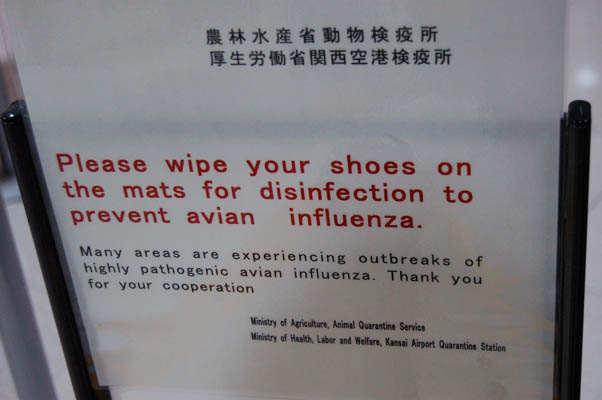
What can these mats really do make sure that avian influenza doesn’t enter the country? I think they’re there just to make everyone feel better, kind of like making people wait two hours to pass through security when you go to LAX makes us feel safer. Because they’re special mats!
When you return overseas to work in Japan, why not have some fun with it or milk a little vacation? Pretend to sneeze, wipe your hand on your pants, and then shake hands with people when you arrive. Talk to them about how much you loved the local delicacy, pigeon sashimi, when you visited the country regions of any place tht has been in the news regarding avian flu outbreaks. Every so often, let out a muffled cough towards your victim and cover your mouth with a few gaps between your fingers (Note: if you do this, you run the risk of being labeled an a**hole, and you really shouldn’t be doing this if you really are sick).
If you are on the JET program, this should be a sure-fire way to get you some extra “vacation” (they’ll likely quarantine you for a week). It happened three years ago with the SARS outbreak, resulting in a Kumamoto-ken-wide quarantine of JETs who had traveled abroad during the heights of the scare. Everyone, except for me, that is. Even though I came back to Japan with a cold and a severe case of southeast asian microorganisms not agreeing with my digestive system. Actually, I was glad to get back to work, and quite thankful that they didn’t make me go in to a lab to be tested by paranoid government workers. That would have sucked!


